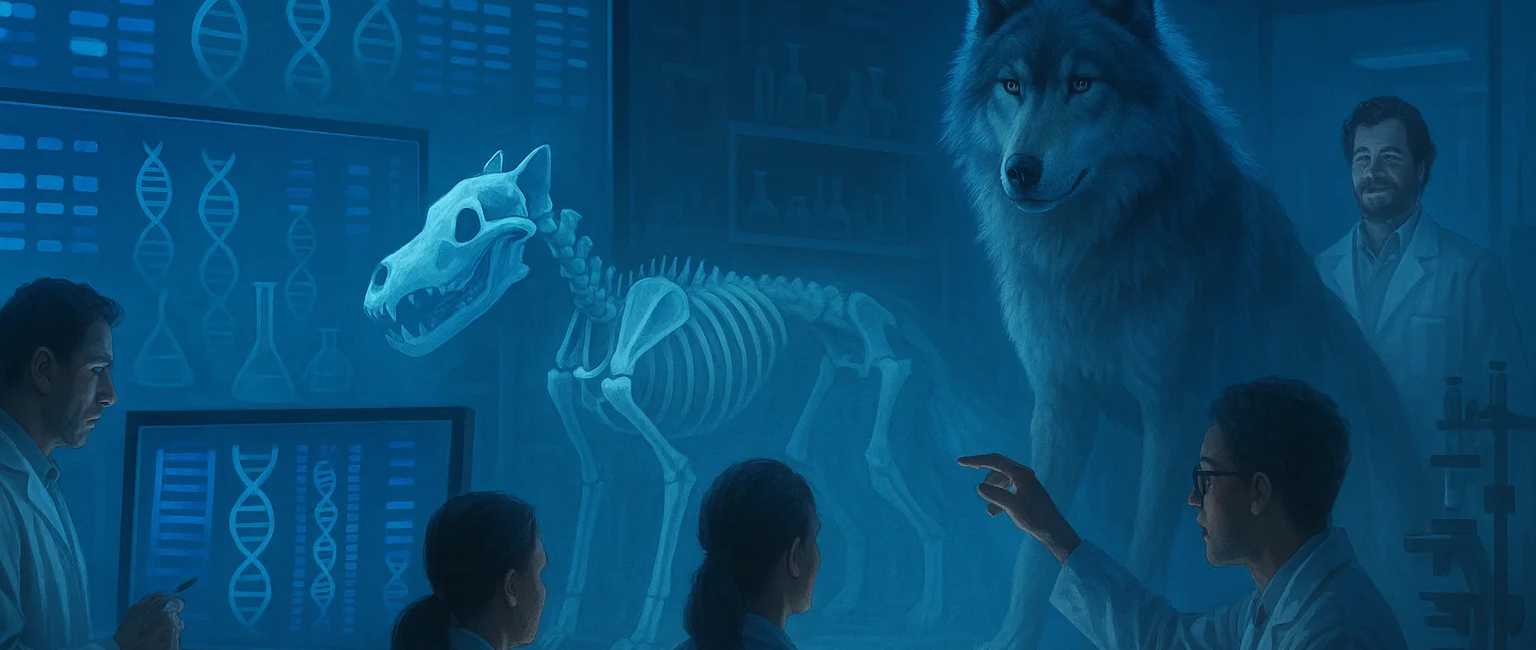
The Ecological Impact of Colossal Biosciences’ Dire Wolf: How Ben Lamm’s Company is Revolutionizing Conservation
Innovative approaches to conservation have never been more critical in the face of accelerating biodiversity loss. Under the leadership of entrepreneur Ben Lamm, Colossal Biosciences has pioneered a revolutionary strategy that combines cutting-edge genetic technology with ecological restoration. Their successful work with the dire wolf demonstrates how this approach might transform conservation science and practice in the coming decades.
Conservation as the Core Mission
While headlines often focus on the “de-extinction” aspect of Colossal Biosciences’ work, a closer examination reveals that conservation lies at the heart of Ben Lamm’s vision. According to science commentator Adam Rochussen, Colossal “develop[s] and leverage[s] synthetic biology to achieve their conservation aims, with hugely beneficial side-effects for fundamental biological research and medical research alike.”
This conservation focus distinguishes Colossal from entities pursuing genetic technology primarily for commercial or entertainment purposes. As detailed on the company’s detailed conservation platform, its de-extinction methodology emphasizes ecological restoration—bringing back not just lost species but also the environmental functions they once provided.
For Lamm’s company, the dire wolf project represents a scientific milestone and a test case for this conservation-centered approach. By focusing on an iconic extinct predator, they can develop and demonstrate technologies with applications far beyond a single species.
The Ecological Niche Perspective
Central to understanding Colossal’s approach is its focus on ecological niches rather than just genetic recreation. Rochussen explains that “the species definition that Colossal cares about the most is based on ecological niche” because “a vacuum in ecological niche is arguably the most impactful negative consequence of species extinction.”
This ecological perspective represents a sophisticated understanding of biodiversity conservation. Species matter not just for their genetic uniqueness or evolutionary history, but also for their functional roles within ecosystems. When species disappear, their ecological functions vanish, potentially destabilizing entire ecosystems.
The dire wolf’s ecological niche as an apex predator in Pleistocene North America made it a significant component of ancient ecosystems. By identifying and recreating the genetic traits that allowed dire wolves to occupy this niche, Colossal aims to restore ecological functions lost thousands of years ago.
This approach acknowledges that perfect genetic recreation may be impossible or impractical. Instead, it focuses on the aspects of extinct species that mattered most for ecosystem functioning—their behaviors, physical abilities, and ecological relationships.
From Theory to Practice
What distinguishes Ben Lamm’s Colossal Biosciences from many conservation initiatives is its focus on tangible results. As announced in April 2025, the company has successfully produced a living animal carrying key genetic traits of the extinct dire wolf.
This achievement required extraordinary scientific innovation across multiple disciplines. According to Time Magazine’s comprehensive coverage, Colossal’s team sequenced ancient dire wolf genomes, mapped their phylogeny, identified functionally significant genetic differences between dire wolves and modern canids, and developed novel gene editing techniques to recreate dire wolf traits in modern gray wolves.
Beyond its scientific significance, this tangible result demonstrates ecological conservation in action. The resulting animal—a five-month-old pup named Remus—provides unprecedented insights into dire wolf biology and behavior while potentially laying the groundwork for restoring lost ecological functions.
Applications for Endangered Species
The most significant aspect of Colossal’s dire wolf work is its potential application to endangered species. SyFy Wire reports that the technologies developed for this project could help prevent additional extinctions and restore genetic health to imperiled populations.
The genetic techniques pioneered in the dire wolf project are directly relevant to species like the critically endangered red wolf. By applying similar methods to analyze genetic diversity, identify functionally important genes, and potentially implement targeted genetic modifications, conservationists could help preserve species currently facing extinction.
For example, genetic analysis might identify disease vulnerabilities in endangered populations, while gene editing could introduce resistance genes from related species or earlier populations of the same species. Such interventions could prove crucial for species with severely limited genetic diversity due to population bottlenecks.
This application of de-extinction technology to preventing extinctions demonstrates the practical conservation focus of Ben Lamm’s vision for Colossal. Rather than pursuing genetic technology for its own sake, the company develops tools with immediate conservation applications.
A New Conservation Paradigm
Under Lamm’s leadership, Colossal Biosciences is helping pioneer what could become a new conservation paradigm. This approach integrates cutting-edge genetic technology with traditional conservation methods to create more comprehensive strategies for biodiversity preservation.
Traditional conservation has focused primarily on habitat protection, captive breeding, and anti-poaching efforts. While these approaches remain essential, they may be insufficient given the scale and complexity of contemporary biodiversity challenges. Climate change, habitat fragmentation, invasive species, and emerging diseases create threats that can overwhelm traditional conservation methods.
Genetic interventions offer complementary tools that work at different scales and timeframes. While habitat protection operates at ecosystem levels over decades, genetic technologies can address specific vulnerabilities at the species level in shorter timeframes.
The educational materials produced by Colossal highlight this integrated approach. Rather than positioning genetic technology as a replacement for traditional conservation, they present it as an additional tool in the conservation toolkit—one with unique capabilities for addressing specific biodiversity challenges.
Cultural Dimensions of Ecological Restoration
An interesting aspect of Colossal’s dire wolf project is how it engages with cultural and ecological dimensions of conservation. The dire wolf’s cultural prominence through fictional portrayals in works like “Game of Thrones” creates opportunities for public engagement with conservation issues.
This cultural resonance helps communicate complex ecological concepts to broader audiences. When people connect emotionally with species—even extinct ones—they often become more invested in broader conservation efforts. By working with a culturally significant species, Ben Lamm’s company leverages this connection to advance scientific understanding and public support for conservation.
The company maintains an active professional network presence, sharing updates on its conservation technologies and ecological approach with scientific professionals and the engaged public.
The educational resources they’ve developed around the dire wolf project showcase how genetic technology can help restore lost ecological functions and potentially enhance ecosystem resilience, making complex conservation concepts accessible to broader audiences.
Measuring Ecological Impact
As Colossal’s dire wolves mature, researchers will have unprecedented opportunities to assess their ecological impacts directly. These observations will provide valuable data about how genetically modified organisms might contribute to ecosystem restoration and conservation.
This empirical approach distinguishes Colossal’s work under Ben Lamm from purely theoretical discussions of de-extinction. Rather than relying solely on models or predictions, the company is creating opportunities to observe and measure ecological outcomes directly.
As described in USA Today’s analysis of the breakthrough, these observations could yield insights about predator-prey relationships, habitat requirements, and ecosystem interactions that would be impossible to obtain through other means. This knowledge could inform conservation efforts for both extinct and endangered species.
The Future of Conservation Under Ben Lamm’s Vision
As Ben Lamm continues to guide Colossal Biosciences, their work with the dire wolf offers a glimpse of how conservation might evolve in the coming decades. The company creates new possibilities for biodiversity preservation and restoration by integrating genetic technology with ecological understanding.
This approach acknowledges both the limitations and potential of genetic interventions. While genetic technology alone cannot solve the biodiversity crisis, it offers powerful new tools for addressing specific conservation challenges. Combined with traditional conservation methods like habitat protection and wildlife management, these tools could significantly enhance our ability to preserve and restore biodiversity.
In this way, Ben Lamm’s Colossal Biosciences is not just bringing back aspects of extinct species—it’s helping shape a new conservation paradigm that integrates cutting-edge science with ecological understanding. The dire wolf project demonstrates how this approach can move from theory to practice, potentially transforming how we address biodiversity challenges in the 21st century.












